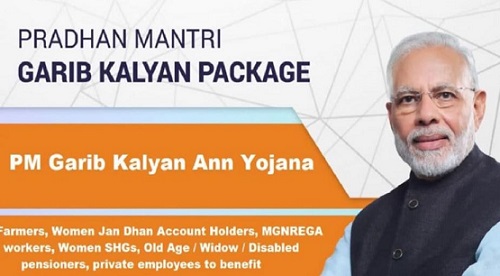By Bibhu Prasad Sahu
BERAHMPUR: India, has faced the brunt of COVID-19 hence the Government of India declared as a ‘notified disaster’ as a “critical medical condition or pandemic situation.” Under the Disaster Management Act 2005, the centre and the states decided to enforce a lockdown and restrict public movement. The economic impact of the lockdown has been extensively disruptive to the millions of people, especially those relying on informal modes of livelihood. With economic activities coming to a standstill, factories not running, and markets being shut; there has been a disruption in work, wages and food for a vast majority of Indian population who rely on daily work and daily cash, with little provisions of employment protection.
Thus, the Finance Minister Nirmala Sitharaman, as part of the relief package announced for all account holders under the Pradhan Mantri Jan Dhan Yojana (PMJDY) to receive cash transfers of Rupees 500 every month for three months starting from April 2020. The original idea behind the cash transfers is to ease the financial stress of the worst hit sections of the society because of the implemented lockdown.
Taking note of the large scale in which the project is being implemented, Youth for Social Development (YSD), a grassroots development organization based in Berhampur, Ganjam in Odisha has conducted a rapid assessment to understand the implementation of the distribution of PMJDY amounts to the women beneficiaries across urban and rural areas in Ganjam district of Odisha State.
The rapid assessment was conducted across 7 locations in Ganjam District in Odisha and a total of 252 participants from the seven areas were administered this survey. The assessment was done through a short survey consisting of 16 questions. 43% of the respondents are homemakers and 48% are working in private and government services and 6% are students.
The major findings of the rapid assessment are as follows;
A vast majority of the residents (95%) in Ganjam district had operational Jan Dhan Accounts, which was linked to their AADHAR number. This indicates the government’s efficiency in reaching the poor account holders by eliminating intermediaries.77% of the 252 surveyed respondents were aware of the Pradhan Mantri Jan Dhan Yojana and Garib Kalyan package announced during Covid-19 and lockdownWe observed that over three-fourths (77%) of the participants in the study had received the Rs. 500/- cash transfer for April and May when the study was being conducted.
However, we cannot ignore the 11% of respondents in the survey who did not receive the cash transfer despite having an operational Jan Dhan Accounts.
We also found that a large number of beneficiaries (75%) still had to rely on physical visits to the bank to confirm the deposit into their accounts, and withdrawal of the amounts.
65% have got the knowledge about their account’s financial status by visiting banks physically and 28% through SMS. The survey also found that many respondents did not and any knowledge of receipt of money in their accounts.
Lack of an effective communication mechanism between the beneficiaries with the government officials and bank staffs who could elaborate on the reasons for which they could not receive the amount.30% of the respondents had to travel over 10 kilometres to reach a bank for withdrawing their deposit, which would have been a significant hurdle to overcome under the lockdown restrictions imposed by the government.
45% of the respondents had issues with the long queues in the bank, 20% were frustrated with the multiple link failures occurring in the bank, preventing them from checking their account status or withdrawing their deposits.43% of the residents decided not to withdraw the amounts for fear of the lockdown and contracting the virus and 28% couldn’t get time due to agriculture work, 11% found bank closed when they reach, and most importantly 7% people denied withdrawing due to not maintain of minimum balance of Rs.2000. Majority of the respondents (50%) used the received amounts for purchase of grocery and essential items. Others used it for rent, health expenses (14%) as well as for their children’s education (12%). It is a positive sign that majority of the people are content with the deposits from PMJDY.
We have some policy suggestions which need to be implemented in an urgent basis
There is high need for an accessible, transparent, and an empathetic process where the poor and the semi-literate bank account holders are treated well in the banks, and the officials are proactive in their approach to assist.The gap could be mitigated through the presence of an umbrella institution which hears the grievances of the beneficiaries and assists them urgently. Assigning responsibility to a dedicated financial institution such as National Bank for Agriculture and Rural Development (NABARD) with its extended reach could be considered for addressing customer grievance, and monitor other aspects of financial inclusion.
Looking at the beneficiaries receipt of information and knowledge about their account’s financial status, can be only catered through a larger, regular, and institutional engagements (could be through host banks monitored by regulators facilitated with appropriate technological support) to address the necessary gaps. If not, the larger purpose of opening the accounts for greater financial inclusion gets defeated.Our findings reiterate the fact that connectivity and technological challenges still present itself as a considerable challenge in the implementation of PMJDY. People still rely on physical visits to the bank to check their account status, even if the banks are located far away from their residences.Moreover, banks in small towns and rural areas still suffer from technological issues, failing to meet the demands of account holders at a particular time. Use of innovative facilities such as biometric enabled and multi-lingual hand-held devices should be encouraged in the rural areas which do not have easy accessibility to banks.
These devices could have the functionality of cash withdrawals and deposits; scanning documents to facilitate new account openings and loan disbursals; voice commands and narration for all available facilities; all through a multi-lingual format that would help increase the banking penetration. At the same time, it becomes also essential for inculcating necessary financial skills and a minimum business acumen to the account holders through awareness programs for them to be able to use the Jan Dhan Accounts to their advantage.With a significant variation in the socio-economic background of people living in India, there is a need for a greater flexibility in the financial segments designed for different segments of the unbanked population.
Standard instruments such as recurring deposit schemes that are specifically offered to salaried segments of the society would need to differ in rural areas depending on the cycle of agricultural produce. Irregular and infrequent income spurts do not allow people employed in the informal sector to maintain savings in a recurring deposit account.The situation demands larger action points such as improvement in financial and technological literacy, business development and entrepreneurial services including product and marketing knowledge, etc other than just direct benefit transfer and transfer of financial assistance during emergencies like these.
Given the urgency of the situation and the fact that millions of families are currently facing the risk of falling into extreme poverty, offering an array of savings instruments that suit people’s life cycles in different parts of the country and identifying the loopholes in the relief measure around the last mile delivery is required without further delay.



























